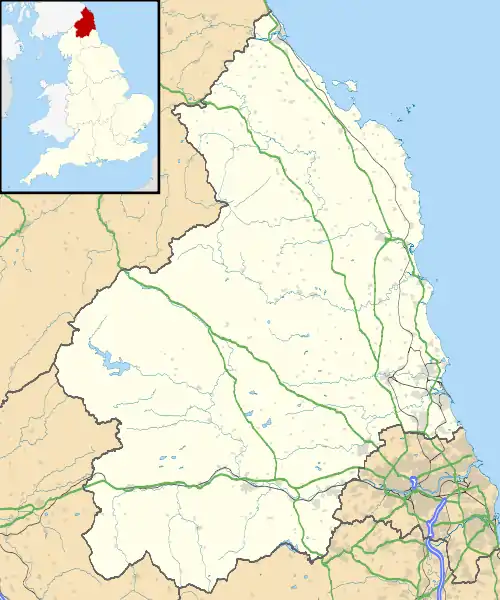Scremerston
Scremerston is a village in Northumberland, England. The village lies on the North Sea coast about 3 miles (5 km) south of Berwick-upon-Tweed and adjacent to the A1, providing access to Newcastle upon Tyne to the south, and to Edinburgh to the north.
| Scremerston | |
|---|---|
 Old A1 running through Scremerston | |
 Scremerston Location within Northumberland | |
| OS grid reference | NU005495 |
| Unitary authority | |
| Ceremonial county | |
| Region | |
| Country | England |
| Sovereign state | United Kingdom |
| Post town | BERWICK-UPON-TWEED |
| Postcode district | TD15 |
| Dialling code | 01289 |
| Police | Northumbria |
| Fire | Northumberland |
| Ambulance | North East |
| UK Parliament | |
History
The lands historically were held by the Radcliffe family, Earls of Derwentwater, but when James the last earl was tainted in 1716 the lands were granted to the Commissioners of Greenwich Hospital. At the end of the nineteenth century the sole landowners are given as the Lords of the Admiralty.
Geological variations in this area allowed many coal seams to develop, some two feet thick, and were among the earliest coal formations in Britain. There were extensive collieries and manufactories of lime, bricks and tiles around Scremerston, and this, as well as agriculture, were the mainstays for employment for people in the area.
The soil is of a clay nature, perfect for the making of bricks and tiles. Crops such as wheat, beans, barley, oats and turnip were grown. The parish is largely agricultural, but the influence of mining is responsible for the growth of the township, though today all of those mines have been closed.
Governance
Scremerston is in the parliamentary constituency of Berwick-upon-Tweed.
Landmarks
The Devil's Causeway passes the village less than 1 mile (2 km) to the west. The causeway is a Roman road which starts at Port Gate on Hadrian's Wall, north of Corbridge, and extends 55 miles (89 km) northwards across Northumberland to the mouth of the River Tweed at Berwick-upon-Tweed.
Religious sites
The Anglican church of St. Peter's, built in the Early English style, was consecrated in 1842. There was also a Primitive Methodist chapel built in 1886 at a cost of nearly £400. The population for 1851 is given as 1,152 people though by 1891 it had fallen to 890.
External links
| Wikimedia Commons has media related to Scremerston. |
- Northumberland Communities (Accessed: 12 November 2008)